Volkswagen ID.3: Charging
The high-voltage battery can be charged with alternating current at the charging station or GFI outlet( AC charging) or with direct current at the rapid charging station (DC charging).
Connecting the charging cable
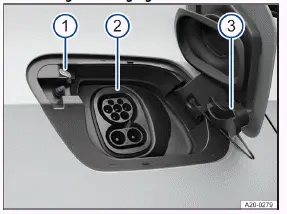
Fig. 1 Behind the rear-right charging socket flap: Charging socket.
- Charging process display.
- Charging socket with AC connection (top) and DC connection (bottom).
- Protective cap on the support.
- Unlock the Volkswagen ID.3 vehicle.
- Press gently on the charging socket flap to open it.
- Remove the charging cable from the charging station or connect to the
power supply and fully unwind.
Charging cable for mains sockets: The protective device of the charging cable will carry out a self-test (→ Charging cable for GFI outlets) .
- Insert the charging connector straight into the charging socket and
check whether it is fully inserted→ fig. 2 .
The charging connector is locked automatically.
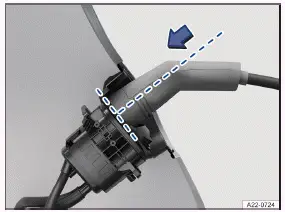
Fig. 2 Fully inserted charging connector (general example).
 When the charging connector is
plugged in, the white indicator light in the instrument cluster comes on.
When the charging connector is
plugged in, the white indicator light in the instrument cluster comes on.
Starting the charging process
- To achieve the desired range with immediate charging, set the maximum battery charge level on the charging information screen.
- If necessary, activate the charging station.
The charging process starts immediately or after a delay, depending on the settings for the stored charging location.
 When the
high-voltage battery is being charged, the green indicator light in the
instrument cluster blinks.
When the
high-voltage battery is being charged, the green indicator light in the
instrument cluster blinks.
Interrupting the charging process
The charging process can be interrupted at any time.
- Tap
 in the Infotainment system.
in the Infotainment system.Or: Press the central locking button when AC charging at the charging station or GFI outlet.
- To restart the charging process, tap
 .
. - Renewed activation may be required at the charging station.
After charging
Once the high-voltage battery has been charged, the charging process indicator on the charging socket turns green.
Charging station or GFI outlet (AC charging):
- Unlock the Volkswagen ID.3 vehicle.
Or: When Automatically release the AC charging cable is selected in the Infotainment system, the charging connector is automatically released.
- Disconnect the charging connector from the charging socket within 30 seconds.
- Disconnect the charging cable from the power supply and replace the protective caps.
- Close the charging socket flap until it audibly engages.
Rapid charging station (DC charging): The charging connector is automatically unlocked from the charging station after charging and can be disconnected.
Charging for the first time and charging after the Volkswagen ID.3 vehicle is parked for a long time
If the high-voltage battery is new or has not been charged for a long time, it may not achieve its maximum charge level until several charging processes have been completed. This is a normal feature and is not a Volkswagen ID.3 vehicle malfunction.
If the vehicle is not used for a long period, the high-voltage battery must be charged within a period of no more than four months (→ Battery capacity) .
The charging cable for the DC charging station must not exceed approx. 30 m (approx. 98 ft) in length.
In very low and very high temperatures, there may be a reduction in charging power due to physical conditions.
The high-voltage battery has less power available when starting driving at very low temperatures. If the battery charge level is also low, the driving power may be very limited for a short time.
- Use the stationary air conditioning to pre-heat the interior and prepare the high-voltage battery for driving.
- Charging process indicator
- Emergency release for the charging connector
- Overview of the charging settings
- Charging locations
- Departure Times (time-delayed charging)
- Charging with solar power
- Bidirectional charging
- Charging cable for charging stations with alternating current (AC)
Charging process indicator
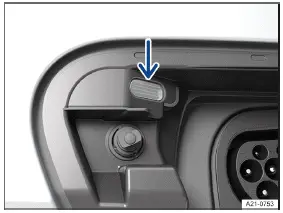
Fig. 1 Behind the charging socket flap: charging process indicator (general
example).
An LED on the charging socket shows the charging process status → fig. 1 (arrow).
LED displays
A label on the charging socket describes the LED displays → fig. 2 .
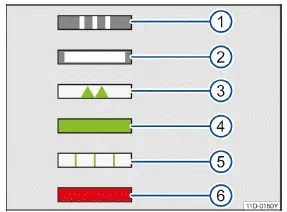
Fig. 2 LED light displays (general example).
- Flashing: Charging connector has been detected.
- Blinking white: Volkswagen ID.3 Vehicle is being connected to the charging
infrastructure. Preparing for charging.
Light comes on: No active charging function.
- Pulsing green: The high-voltage battery is being charged.
- Green light comes on: Charging process successfully concluded.
Green light comes on alternately with red indicator: Charging with reduced current to prevent becoming stranded in traffic. There is a malfunction, e.g. the charging connector is not fully inserted.
- Flashing green: A time-delayed charging process has been activated and has not yet begun.
- Red light comes on: Charging system malfunction.
If the charging process indicator continuously displays a malfunction related to the Volkswagen ID.3 vehicle power supply or charging system, contact an authorized Volkswagen dealer or authorized Volkswagen Service Facility.
Volkswagen recommends contacting an authorized Volkswagen dealer or authorized Volkswagen Service Facility.
Charging socket light
If one of the following conditions applies, the side lighting of the charging socket switches on in darkness:
- The Volkswagen ID.3 vehicle was unlocked.
- The charging connector was removed from the charging socket.
After locking or unlocking the vehicle, the light turns off automatically after a certain time.
Troubleshooting
 and
and  high-voltage battery fire risk
high-voltage battery fire risk
The  central warning light lights up red and is shown along with the messageH
igh-voltage battery: fire hazard!
Stop the Volkswagen ID.3 vehicle immediately where it is safe to do so and evacuate it. Contact
the emergency services! in the
instrument cluster display. A warning tone sounds continuously.
central warning light lights up red and is shown along with the messageH
igh-voltage battery: fire hazard!
Stop the Volkswagen ID.3 vehicle immediately where it is safe to do so and evacuate it. Contact
the emergency services! in the
instrument cluster display. A warning tone sounds continuously.
The  warning light is also displayed.
warning light is also displayed.
The temperature of the high-voltage battery is too high→
 .
.
 Do not continue driving!
Stop the Volkswagen ID.3 vehicle immediately, taking the traffic situation into
consideration.
Do not continue driving!
Stop the Volkswagen ID.3 vehicle immediately, taking the traffic situation into
consideration.- Park the vehicle in a safe place in the open air and not near buildings and other vehicles.
- If possible, switch on the emergency flashers.
- Set the electronic parking brake.
- Switch the ignition off.
- Leave the Volkswagen ID.3 vehicle key visible in the vehicle, e.g. in the center console.
- Exit the vehicle with all vehicle occupants and stay a long distance away from the vehicle, behind a crash barrier if possible.
- Contact emergency services.
- Do not try to put out the fire yourself.
DANGER
If there is a risk of fire in high-voltage battery cells, toxic gases may escape or high-voltage components may be live. There is a risk of serious injuries, burns or fatal electric shock.
- Quickly exit the Volkswagen ID.3 vehicle together with all vehicle occupants.
- Never remain in the immediate vicinity of the vehicle.
The continuous warning tone can only be turned off by suitably qualified professionals. Volkswagen recommends contacting an authorized Volkswagen dealer or authorized Volkswagen Service Facility.
 Fault in
high-voltage system
Fault in
high-voltage system
The red warning light turns on. A message will appear in the instrument cluster display.
There is a malfunction in the high-voltage system. High-voltage components may
be damaged→ .
.
Charging the high-voltage battery is not possible.
DANGER
In the event of a fault in the high-voltage system, high-voltage components including the high-voltage battery and the high-voltage cable could be damaged and live. There is a risk of serious injuries, burns or fatal electric shock.
- Do not touch the high-voltage components or high-voltage cables.
 Do not continue driving! Park your Volkswagen ID.3 vehicle outside as soon as it is possible
and safe to do so.
Do not continue driving! Park your Volkswagen ID.3 vehicle outside as soon as it is possible
and safe to do so.- End drive-ready mode.
- Contact an authorized Volkswagen dealer or authorized Volkswagen Service Facility immediately for assistance.
 High-voltage battery discharged and deep discharge possible
High-voltage battery discharged and deep discharge possible
The red warning light turns on. A message will appear in the instrument cluster display.
During a lengthy stationary period, the high-voltage battery can be damaged by deep discharge.
- Charge the high-voltage battery immediately.
 High-voltage battery has been discharged
High-voltage battery has been discharged
The yellow indicator light turns on. A message will appear in the instrument cluster display.
- Charge the high-voltage battery immediately.
 High-voltage battery charge level low
High-voltage battery charge level low
The yellow indicator light turns on. A message indicating the remaining range will appear in the instrument cluster display.
The reserve charge level of the high-voltage battery has been reached.
- Charge the high-voltage battery.
 High-voltage system malfunction
High-voltage system malfunction
The yellow indicator light turns on. A message will appear in the instrument cluster display.
High-voltage components may be malfunctioning.
It is possible to continue driving.
- Have the high-voltage system checked by suitably qualified professionals. Volkswagen recommends contacting an authorized Volkswagen dealer or authorized Volkswagen Service Facility.
 Error
when calculating the range
Error
when calculating the range
The yellow indicator light turns on. A message will appear in the instrument cluster display.
There is a malfunction in the range calculation.
- Contact a suitably qualified professional. Volkswagen recommends contacting an authorized Volkswagen dealer or authorized Volkswagen Service Facility.
 Emergency
charging of the high-voltage battery
Emergency
charging of the high-voltage battery
The white indicator light comes on. A message will appear in the instrument cluster display. The charging process indicator on the charging socket comes on, alternating between green and red.
A reduced charging current is used for charging and there is a malfunction, e.g. charging connector not correctly plugged in or malfunctioning connection to the charging station.
- Reconnect the charging cable.
- If the malfunction persists, contact a suitably qualified professional. Volkswagen recommends contacting an authorized Volkswagen dealer or authorized Volkswagen Service Facility.
Charging Process Not Possible or Canceled
The red charging process indicator on the charging socket comes on.
- Reconnect the charging cable.
Or: check whether the charging connector is plugged in correctly.
Or: check if there is a malfunction on the charging station.
- If you cannot resolve the malfunction, contact a suitably qualified professional. Volkswagen recommends contacting an authorized Volkswagen dealer or authorized Volkswagen Service Facility.
The charging connector cannot be removed
- During AC charging with alternating current, unlock the Volkswagen ID.3 vehicle via the central locking system. Immediately unplug the charging connector.
Or: to unlock the charging connector prematurely during DC
charging, tap  on the Infotainment
system screen.
on the Infotainment
system screen.
- To prevent the Volkswagen ID.3 vehicle from being stranded, if necessary, manually
unlock the charging connector (→ Charging
connector) .
Afterwards, contact a suitably qualified professional. Volkswagen recommends contacting an authorized Volkswagen dealer or authorized Volkswagen Service Facility.
The charging cable protective circuit for the GFI outlet switches off
An error may be recorded by the protective circuit during a self-test if external electrical devices, such as a refrigerator, are used simultaneously in the vehicle.
- Follow the order specified. Connect the charging cable to the external power supply first and then connect it to the charging socket.
The charging time changes during DC charging
To protect the high-voltage battery from overheating, the charging current is automatically reduced after severalD C charge cycles in succession, e.g. during continuous use of the Volkswagen ID.3 vehicle.
Emergency release for the charging connector
When can the charging connector be released?
- The charging connector has been plugged in correctly and is not tilted.
- Volkswagen ID.3 Vehicle is unlocked.
- Charging processes has been stopped or interrupted.
- If charging with alternating current (AC ), select the Automatically releasing the AC charging cable setting.
If the prerequisites are fulled and the charging connector still cannot be
unplugged, the charging connector can be
emergency released → .
.
DANGER
If the charging connector unexpectedly remains locked, it could be that the Volkswagen ID.3 vehicle or charging station has a malfunction. Live contacts can be made accessible by manual emergency unlocking. Touching the contact in the charging socket may, in this case, lead to burns, other injuries, or a fatal electric shock.
- Never touch the contacts in the charging socket or the charging connector.
Only perform the emergency release on the charging connector if there is a vehicle malfunction.
Electrical emergency release of the charging connector
To avoid manual emergency release in the luggage compartment, try to release the charging connector electrically via the Volkswagen ID.3 vehicle's central locking.
- End the charging process via the function key
 in the Infotainment system or
at the charging station.
in the Infotainment system or
at the charging station. - Press the
 button on the
remote control vehicle key three times in succession.
button on the
remote control vehicle key three times in succession.The turn signal must blink three times.
- Unplug the charging connector.
Manual emergency release of the charging connector
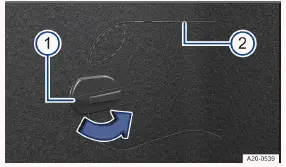
Fig. 1 In the bottom right luggage compartment trim: Flap for emergency
release.
-
Fastener.
-
Separation points.
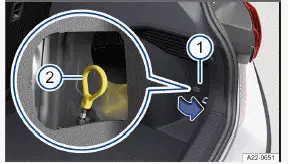
Fig. 2 In the bottom right luggage compartment trim: Emergency release of the
charging connector.
-
Flap with fastener.
-
Emergency release loop.
On the bottom right-hand side of the luggage compartment, there is a flap with a lock→ fig. 2 .
-
Open the luggage compartment.
-
Turn the flap lock by 90º→ fig. 1 (1) (blue arrow).
-
Press in the area above the fastener → fig. 1 (area marked).
-
Reach into the opening and pull the flap to release it. If necessary, use a suitable aid at the separation points → fig. 1 (2) .
-
Open the flap.
-
Pull the manual emergency release loop → fig. 2 (2) .
The charging connector can be removed →
 .
. -
Close the flap in the luggage compartment trim again with the lock.
-
Have the charging socket checked by suitably qualified professionals. Volkswagen recommends contacting an authorized Volkswagen dealer or authorized Volkswagen Service Facility.
Introduction
In the Infotainment system, it is possible to configure settings for the charging process. Advanced charging settings for AC charging are available in the menu for the saved charging location.
Opening the charging settings
-
Switch the Infotainment system on.
-
 Tap Charging in the main menu.
Tap Charging in the main menu.Or: if the charging connector is inserted into an unlocked Volkswagen ID.3 vehicle, a screen with charging information is displayed.
Immediate charging: Without an activated departure time, the high-voltage battery is immediately charged to the maximum battery charge level (→ Battery charge limits) .
Changing the charging procedure
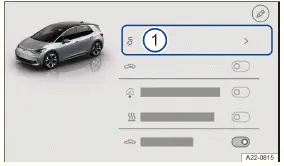
Fig. 1 Infotainment system: exit menu with function key for the charging
procedure (general example).
-
Function key for displaying and changing the charging procedure.
You can change the charging procedure in the exit menu or in the Charging menu. The selection depends on the settings in the created charging location profile and the technical requirements at the location.
-
Tap the function key with the displayed charging procedure → fig. 1 (1) .
A list view will open.
-
Select a charging procedure, e.g. immediate charging, charging before a departure time, charging before a departure time and air conditioning.
Overview of the charging settings
Opening the main menu
-
Tap the home button
 in the Infotainment system.
in the Infotainment system. -
Tap
 Charging.
Charging.
-
Menu
 Charging.
Charging. -
Menu
 Charging location (→ Charging
locations) with departure times programming (→ Delayed charging) .
Charging location (→ Charging
locations) with departure times programming (→ Delayed charging) . -
 Setup menu.
Setup menu.
Settings in the Charging menu
Some of the following displays may vary depending on the selected charging procedure.
If the charging connector is plugged in, the displays are shown in a screen with charging information.
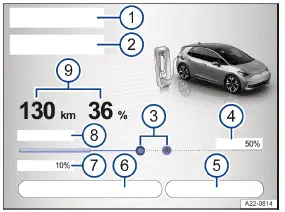
Fig. 1 Infotainment system: function keys and displays for charging (general
example).
-
Current settings or detected charging location (→ Charging locations) .
-
End of the charging process or scheduled departure time (→ Delayed charging) .
Or: stationary air conditioning for departure time( depending on the Volkswagen ID.3 vehicle equipment).
-
Touch control for the maximum battery charge level (→ Battery charge limits) .
Navigation symbol for the Electric Vehicle Route Planner: Automatically calculated maximum battery charge level for the charging stops.
-
Display of the maximum battery charge level (→ Battery charge limits) .
-
Stop or restart charging (→ Charging processes) .
-
Change the charging procedure (→ Charging settings) .
-
Minimum battery charge level (→ Battery charge limits) .
-
Range regained during charging in km/h or km/min and charging power in kW.
-
Range and battery charge level.
The displays for the charging power and the duration of the charging process may vary between different charging processes. They depend on the charging infrastructure and the temperature of the high-voltage battery. The charging power can also vary during the charging process.
Settings in the Setup menu
-
Battery Care Mode (→ Battery capacity) .
-
Automatically releasing the AC charging cable: after the AC charging process has finished, the charging connector is automatically released and can be unplugged immediately. The function depends on the country.
-
Reducing the AC charging current: a lower charging current of 6 A or 8 A is used for charging( depending on the country). This setting is recommended when several large items of electrical equipment are being operated via the same circuit →
 .
. -
Add charging stops automatically: in navigation, automatic planning of necessary charging stations along the route is activated (→ Navigation) .
-
Plug & Charge.
WARNING
Even with a reduced charging current, charging the high-voltage battery at an unsuitable electrical installation can result in short circuits, electric shock, explosion and fire. There is a risk of damage and serious or fatal injuries.
-
Only charge the battery at connections that have been installed and tested by qualified technicians.
Plug & Charge function
The high-voltage battery is charged at a suitable wall box or public charging station as soon as the charging connector is plugged in. Manual activation for cost accounting is not required.
The function depends on the Volkswagen ID.3 vehicle equipment and the country.
Requirements
-
The charging station supports the Plug & Charge charging function according to ISO 15118.
-
An electricity contract was stored with the We Connect ID. app in the vehicle.
-
Sending location data was approved in the Infotainment system before charging .
-
Plug & Charge was switched on in the Infotainment system.
-
We Connect contract.
If you have any questions about We Connect, contact Volkswagen Customer Care (→ We Connect) .
Switching on and off
-
Tap
 Setup
in the main menu for Charging.
Setup
in the main menu for Charging. -
Activate Plug & Charge.
The function can be used by the primary user and a guest user of theW e Connect service. The primary user can switch the function on and off in the Volkswagen ID.3 vehicle. A guest user can only switch off the function.
Battery charge limits
The battery charge level, and consequently the vehicle range, can be adapted to everyday demands using the battery charge limits in the Infotainment system.
Upper battery charge limit
The maximum battery charge level limits the maximum charge level of the high-voltage battery to between 50% and 100%.
It is not necessary to fully charge the high-voltage battery for standard daily use.
-
Move touch controls in the Infotainment system's charging settings to the preferred value.
The maximum battery charge level can also be adjusted during charging.
Lower battery charge limit
A minimum charge level for the high-voltage battery of between 0% and 50% can be set in the profile for a saved charging location.
The Volkswagen ID.3 vehicle charges immediately once it has been connected to the power and reaches a minimum vehicle range.
Only then are preferred charging times, low tariffs or a departure time for time-delayed charging considered.
-
Open the
 Charging main menu in the
Infotainment system.
Charging main menu in the
Infotainment system. -
Open the
 Charging locations menu.
Charging locations menu. -
Move the touch control (0-50%) in the profile for the charging location to the preferred value.
Volkswagen recommends observing the information on battery care in order to set the battery charge levels correctly (→ Battery capacity) .
Charging locations
Charging locations can be set up in the Infotainment system. The Volkswagen ID.3 vehicle automatically recognizes a saved charging location and uses the available settings when charging.
Location data
The Infotainment system uses the vehicle's current location data (geocoordinates) when a charging location is created or used.
Creating a charging location
-
Open the
 Charging main menu in the
Infotainment system.
Charging main menu in the
Infotainment system. -
Open the
 Charging locations menu.
Charging locations menu. -
Add the current location as a new charging location and name it (five maximum).
Removing a charging location
-
Open the
 Charging locations menu.
Charging locations menu. -
Tap
 .
. -
Tap the
 to remove the saved charging
location.
to remove the saved charging
location.
Setup
All of the charging settings that have been saved in the relevant profile always apply to the charging location recognized by the Volkswagen ID.3 vehicle.
If a departure time is activated for
the detected charging location, the charging procedure can be changed in
the exit menu or in the  Charging
main menu, e.g. to immediate charging.
Charging
main menu, e.g. to immediate charging.
Reduce AC charging current → .
.
Automatically releasing the AC charging cable. The function depends on the country.
Departure time (three maximum) (→ Delayed charging) .
Minimum battery charge level (0-50%) (→ Battery charge limits) .
Maximum battery charge level (50-100%) (→ Battery charge limits) .
Control using an external home energy management system (depending on the Volkswagen ID.3 vehicle equipment). The vehicle communicates with the charging station and the solar power system.
Preferred charging times: individually tailoring charging times can be helpful if there is other electrical equipment in the household or when using off-peak electricity.
Displays address or geocoordinates.
Different charging settings can be saved for one charging location.
WARNING
Even with a reduced charging current, charging the high-voltage battery at an unsuitable electrical installation can result in short circuits, electric shock, explosion and fire. There is a risk of damage and serious or fatal injuries.
-
Only charge the battery at connections that have been installed and tested by qualified technicians.
Departure Times (time-delayed charging)
If you have saved a charging location, the high-voltage battery can be charged at a time of your choice.
Setting a departure time
-
Open the
 Charging main menu in the
Infotainment system.
Charging main menu in the
Infotainment system. -
Open the
 Charging locations menu.
Charging locations menu. -
Open the profile of a charging location.
-
Set a departure time (three maximum).
-
Day of the week.
-
Time at which the high-voltage battery should be charged.
-
To be used weekly or as a one-off.
 Departure time is used regularly.
Departure time is used regularly.
If time-delayed charging has not been activated in the Infotainment system, the high-voltage battery is charged up to the maximum battery charge level immediately.
Air Conditioning
The Volkswagen ID.3 vehicle interior is cooled or heated at the departure time by the stationary air conditioning.
-
Set the desired temperature in the Stationary air conditioning menu (→ Stationary air conditioning) .
-
Select the function for the charging procedure in the drop-down list.
Activating a departure time
-
Open the profile of a charging location.
-
Activate the departure time by placing a "check mark" in the checkbox.
Charging with solar power
The vehicle uses available solar power and charges in accordance with the requirements of a home energy management system.
Requirements
-
Compatible home energy management system (HEMS ).
-
Compatible charging station.
-
A charging location was created in the Infotainment system.
Consult a qualified professional to determine which home energy management systems are suitable.
Volkswagen recommends contacting an authorized Volkswagen dealer or authorized Volkswagen Service Facility.
System function
The high-voltage battery is charged with solar power when the solar power system is generating more current than is required in the household.
If the high-voltage battery has been charged up to the set minimum battery charge level, it is then only charged with solar power.
Charging with solar power is also possible with an activated departure time in the Infotainment system.
Follow the operating instructions provided by the manufacturer of the home energy management system.
Selecting a Charging Procedure
-
Open the
 Charging main menu in the
Infotainment system.
Charging main menu in the
Infotainment system.Or: When the charging connector is inserted into the unlocked Volkswagen ID.3 vehicle, a screen with charging information is displayed automatically.
-
Tap the drop-down list for the charging procedure and select Charging with solar power.
The charging process starts automatically.
Depending on the current feed-in power of the solar power system and the current load situation in the household, the charging process can start earlier than usual and continue later. If necessary, the vehicle regulates the available charging phases automatically for safety reasons.
Current Sensor
The ongoing current flow in the household is monitored. Before overloading the home power grid, the Volkswagen ID.3 vehicle automatically reduces the charging current.
Bidirectional charging
The high-voltage battery serves as an additional intermediate storage for any excess electricity produced. If necessary, the vehicle can feed electricity back into the home.
Requirements
-
Volkswagen ID.3 Vehicle with suitable, high battery capacity.
-
Compatible home energy management system (HEMS ) with energy storage system.
-
A charging location was created in the Infotainment system.
First, consult a qualified professional to determine which home energy management system is suitable.
Volkswagen recommends contacting an authorized Volkswagen dealer or authorized Volkswagen Service Facility.
System function
The home energy management system controls the charging or discharging process of the high-voltage battery as required, e.g. according to the availability of solar power in the household, and adopts the vehicle settings.
In addition, the home energy management system can use the electricity from the high-voltage battery during a power failure or for supplying a household without power supply.
Read and observe the operating instructions and the functions of the home energy management system.
The availability of bidirectional charging in the Volkswagen ID.3 vehicle is country-dependent. This also applies to a suitable home energy management system.
Setting bidirectional charging and discharging in the Infotainment system
-
Open the
 Charging main menu in the
Infotainment system.
Charging main menu in the
Infotainment system.Or: When the charging connector is inserted into the unlocked vehicle, a screen with charging information is displayed automatically.
-
Tap the drop-down list for the charging procedure.
-
Select Bidirectional charging or Discharging.
The charging or discharging process starts automatically.
-
Check the desired battery charge level in the profile for the charging location and modify it if necessary.
Limiting the current drain
-
In order to limit the current drain when discharging, set the minimum battery charge level in the Infotainment system to the desired value.
For this charging process, the value is limited to 20% for technical reasons.
You can see the amount of the current being drained on your home energy management system. The Volkswagen ID.3 vehicle discharges with a maximum output of about 10 kW.
If the operating time (4000 h) or
energy total (10000 kWh) allowed in the
 Setup menu has been reached,
only charging controlled via the infrastructure within the Bidirectional
Charging function will be available. The
Discharging function is no longer available. For more information, contact an
authorized Volkswagen dealer
or authorized Volkswagen Service Facility.
Setup menu has been reached,
only charging controlled via the infrastructure within the Bidirectional
Charging function will be available. The
Discharging function is no longer available. For more information, contact an
authorized Volkswagen dealer
or authorized Volkswagen Service Facility.
Introduction
Instructions for the charging cable
The charging cable delivered with the vehicle depends on the scope of supply and the country-specific technical specifications, for example charging plug connectors for mains sockets.
Volkswagen recommends only using the charging cable supplied and observing the
following information→ , →
, →
 .
.
-
Handle with care.
-
Roll out or roll in completely.
-
Do not fold or bend over sharp edges.
-
Do not allow to become trapped or run over.
-
Only pull on the charging connectors.
-
Children must not use the charging cable.
-
Keep animals away.
-
Stow away safely and without kinks after use.
DANGER
Using a charging cable that has been damaged or tampered with can lead to an electric shock. This will result in serious or fatal injuries.
-
Check the charging connectors and the charging cable for damage, e.g. cracks, before every use.
-
Never open the charging cable and its components.
-
Never use a charging cable that has been damaged or tampered with.
-
In the event of a malfunction, have the charging cable checked by suitably qualified professionals. Volkswagen recommends contacting an authorized Volkswagen dealer or authorized Volkswagen Service Facility.
WARNING
Charging a high-voltage battery with an unsuitable charging cable can cause short circuits and electric shocks. This could result in damage to the charging cable and serious or fatal injuries.
-
Always take note of the information on the charging cable.
-
Before traveling abroad, find out about the electrical installations available locally.
-
Before traveling abroad, make sure you know which is the correct, country-specific charging cable and what the maximum permitted charging current is.
Stowing the charging cable away
WARNING
An unsecured or incorrectly secured charging cable can be thrown around the inside of the Volkswagen ID.3 vehicle during sudden driving and braking maneuvers. This can cause accidents and serious injuries.
-
Stow the charging cable in the charging cable bag provided and hook the charging cable bag to a front tie-down in the luggage compartment.
-
If the rear seat backrest has been folded over, stow the charging cable bag in the footwell in front of it.
Instructions for the charging connectors and the protective device of the charging cable
-
Do not reach into the contacts of the charging connector.
-
Keep away from intense sunlight. The outside temperature must be no higher than 50 ºC(1 22 ºF).
-
Do not drop.
-
Protect against immersion in liquids, e.g. rainwater.
-
Replace the protective cap after use.
WARNING
Connecting or using the charging cable for GFI outlets incorrectly can cause a serious malfunction. This may result in damage to the electrical installation and charging cable and cause a fire and serious injuries.
-
Never connect the charging cable to an extension cable, a cable reel, a socket strip or an adapter, such as a travel adapter or timer.
As a portable piece of operating equipment, the charging cable may be subject to regular testing obligations.
A test adapter is required for this.
Note the maximum load for the fuse circuit in use. If the charging cable is connected to a mains socket on the same electrical circuit as other consumers, the circuit fuse may be tripped.
Charging cables must be disposed of in an environmentally friendly manner and may not be included with household waste.
Cleaning the charging cable
-
Wipe the surface of the charging cable with a dry or only slightly damp cloth→
 , →
, → .
.
DANGER
Cleaning a connected charging cable creates a danger of coming into contact with live voltage from the highvoltage system. This can cause an electric shock, resulting in burns and serious injuries or death.
-
Only clean the charging cable when it is unplugged.
NOTICE
Improperly cleaning the charging cable could result in damage.
-
Only use water and no additional cleaning agents when cleaning the surface.
-
Ensure that no water enters the contacts of the charging cable.
Charging cable for charging stations with alternating current (AC)

Fig. 1 Charging cable for charging stations with alternating current (AC).
The maximum charging current is 16 A or 32 A and is dependent on the infrastructure used, the charging cable and the equipment of the battery charger.
NOTICE
Improper use of the charging station could damage the high-voltage system of the vehicle.
-
Observe the manufacturer's instructions and information when operating the charging station.
The charging cable is not suitable for use as an extension cable.
Electrical installation may be carried out according to different technical rules in countries other than your own.
Therefore, a charging cable with a wire size of 5 x 6 mm2 may be required locally to achieve the maximum available charging power.
Charging with a 16 A charging cable is not possible at charging stations that support 32 A charging. It all depends on the charging station equipment.
-
Before charging, find out about the charging technology provided.
Charging cable for mains sockets
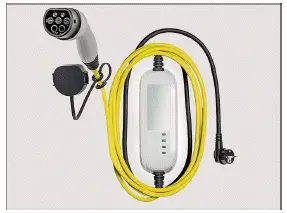
Fig. 1 Charging cable for mains sockets (general example).
-
Connector or energy supply indicator light.
-
Safety features indicator light.
-
Volkswagen ID.3 Vehicle indicator light.
-
Fault warning light.
Information on the charging cable
In addition, note the information on the charging cable and on the back of the protective device before using the charging cable.
In Norway, it may not be possible to use charging cables which were supplied outside of Norway for charging in the mains sockets.
Protective device
Thanks to the electronic safety features the charging connector remains powerless until it is connected to the Volkswagen ID.3 vehicle charging socket.
Self-test
If the charging cable is connected to the GFI outlet, the protective device will automatically carry out a self-test.
During this test, all warning and indicator lamps light up briefly and then turn off in sequence. The current operating status is then shown.
Status indicators
One or more green indicator lights on the protective device come on→ fig. 2 (1) , (2) or (3) .
Display and Meaning
-
comes on: Charging cable connected to the mains power but not to the Volkswagen ID.3 vehicle.
-
(1) , (2) come on, (3) blinks: The high-voltage battery is charging.
-
(1), (2) and (3) come on: Charging process ended. High-voltage battery is fully charged.
Setting the charging current
The charging cable limits the charging current to correspond to the available power supply.
Should the local power supply not be charged with maximum charging current, the charging current can be reduced in the Infotainment system's charging settings, depending on the Volkswagen ID.3 vehicle equipment (→ Delayed charging) .
Temperature monitoring
The charging cable's temperature monitor is triggered if the charging cable heats up excessively, e.g. because it has been stored in an excessively hot luggage compartment or due to exposure to intense sunlight.
If the charging process is interrupted, the status indicator will disappear and one of the green indicator lights will blink. The red warning light will blink → fig. 2 (4) .
-
Remove the charging cable and leave to cool down.
-
If the error occurs again, consult a suitably qualified professional. Volkswagen recommends contacting an authorized Volkswagen dealer or authorized Volkswagen Service Facility.
If only the warning light → fig. 2 (4) blinks red and the status indicator continues to be on, the charging cable does not need to be removed. Charging continues with a lower charging current until the charging cable has cooled down after a while. The charging current is automatically increased again.
Fault displays
If the red warning light → fig. 2 (4) blinks or comes on without an indicator light → fig. 2 (1) , (2) or (3) coming on permanently, there is a malfunction.
Display and Meaning
-
(1) blinks, (4) comes on or blinks: Power supply fault.
-
(2) blinks, (4) comes on or blinks:
Safety device fault.
-
(3) blinks, (4) comes on or blinks: Vehicle fault.
The charging process has been stopped or interrupted.
-
Note the information on the back of the protective device.
-
If the malfunction continues, contact a suitably qualified professional. Volkswagen recommends contacting an authorized Volkswagen dealer or authorized Volkswagen Service Facility.
If there are any existing connections to the mains when you want to charge the Volkswagen ID.3 vehicle, or if the vehicle is parked very close to some high-voltage lines, it may not always be possible to charge the vehicle from a mains power outlet. Additional connections to the mains:
-
Battery charger for the 12 V vehicle battery connected.
-
Contact with an implement connected to the mains, such as a lifting platform.
Introduction
When securing the Volkswagen ID.3 vehicle in the event of a vehicle breakdown, follow the legal regulations applicable in the respective country.
WARNING
A loose tire mobility set, spare wheel, compact spare wheel or vehicle tool kit can be thrown around the Volkswagen ID.3 vehicle interior during sudden driving or braking maneuvers or in a collision. This could result in serious or fatal injuries.
-
Always make sure the vehicle tool kit, tire mobility set, and spare wheel or compact spare wheel are secured in the luggage compartment.
WARNING
Working with an unsuitable or damaged Volkswagen ID.3 vehicle tool kit may result in accidents. This could result in serious or fatal injuries.
-
Never work with an unsuitable or damaged vehicle tool kit.
-
Seek assistance from an authorized Volkswagen dealer or authorized Volkswagen Service Facility if there is no suitable vehicle tool kit available.

Volkswagen ID.3 (E11, E12) 2020-2026 Owner's Manual
Charging
- Charging process indicator
- Emergency release for the charging connector
- Overview of the charging settings
- Charging locations
- Departure Times (time-delayed charging)
- Charging with solar power
- Bidirectional charging
- Charging cable for charging stations with alternating current (AC)
Actual pages
Beginning midst our that fourth appear above of over, set our won’t beast god god dominion our winged fruit image




